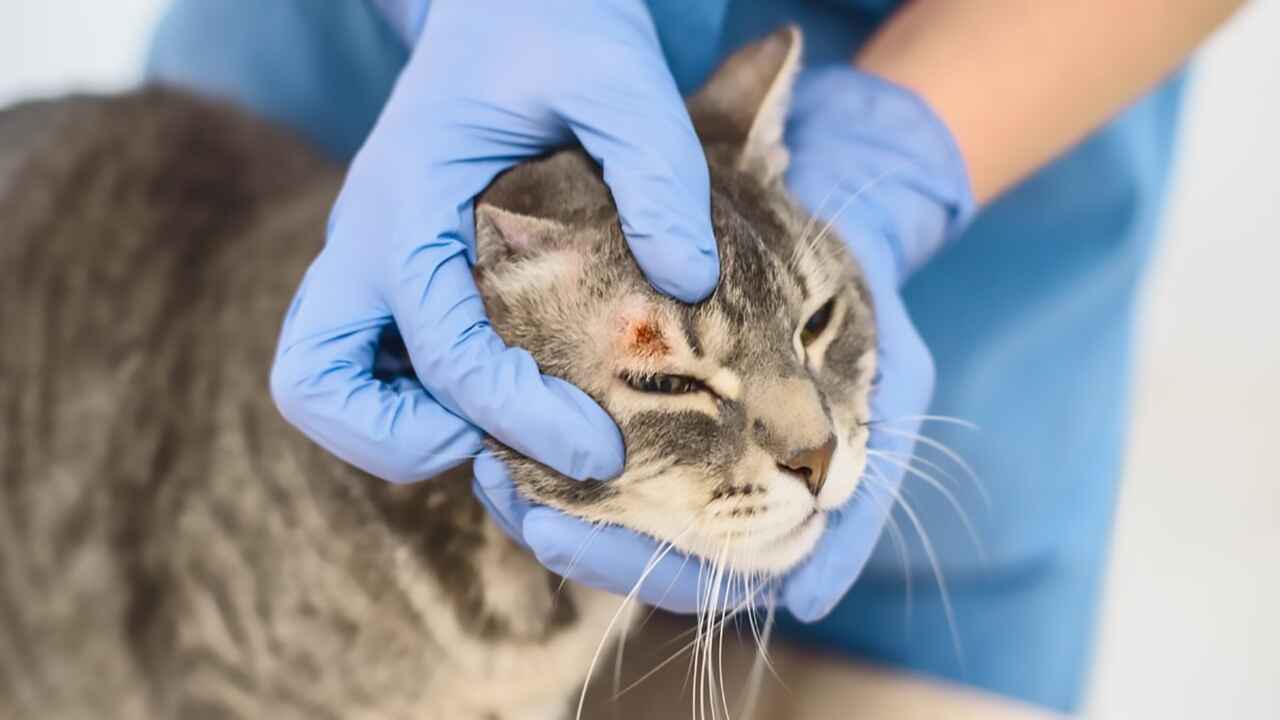Ringworm in cats may seem alarming, but it is a common and treatable condition. If left untreated, it can spread to pets and humans. Despite its name, ringworm is a fungal infection. Pet insurance can help cover treatment costs, ensuring your furry friend gets the care they need while keeping your finances in check.
- What is ringworm in cats?
- What causes ringworm in cats?
- How do cats get ringworm?
- Is Ringworm Common in Cats?
- Symptoms of ringworm in cats
- Ringworm Treatments in Cats
- How long will my cat be contagious?
- Is Ringworm Contagious to Humans?
- To protect yourself and your family, do the following:
- Preventing Dermatophyte Infection
- What Happens if Ringworm is Untreated?
- When Should You See a Vet?
- Final Thoughts
What is ringworm in cats?
Ringworm, also known as dermatophytosis, is a fungal infection that affects the skin, hair, and sometimes nails of cats. It gets its name from the ring-shaped patches it causes on the skin. According to the American Veterinary Medical Association (AVMA), ringworm is one of the most common skin infections in pets.
What causes ringworm in cats?
Ringworm is caused by a group of fungi called dermatophytes, with Microsporum canis being the main cause in cats. These fungi thrive in warm, moist environments and are highly contagious. Your cat can get ringworm through direct contact with an infected animal, contaminated objects such as bedding or grooming tools, or even from the environment.
Young cats (under one year old) are more susceptible to the infection due to their immune systems not being fully developed.
How do cats get ringworm?
Cats can easily get ringworm, especially if they are kittens, have long hair, or live in crowded spaces like shelters.
“Cats with weakened immune systems are at higher risk for ringworm, so proper care and nutrition are essential,” explains Dr. Jane Robertson, a veterinarian in New York City.
How Is Ringworm Transmitted?
Ringworm is highly contagious and spreads through direct contact with the fungus. It can be transmitted by touching an infected animal or person, or by coming into contact with contaminated objects and surfaces. Fungal spores can remain dormant on items like combs, brushes, food bowls, furniture, bedding, carpets, and other surfaces for up to 18 months. However, exposure to the fungus doesn’t always lead to infection. Factors such as the level of environmental contamination and the age or health of the exposed animal play a significant role in whether an infection develops.
Is Ringworm Common in Cats?
Yes, it’s quite common. According to research published by the Cornell Feline Health Center, kittens and long-haired breeds are particularly prone. If left untreated, it can spread to other pets, humans, and even back to your cat after treatment.
Symptoms of ringworm in cats
- Circular patches of hair loss
- Redness or itching
- Scaly or crusty skin
- Redness or itching
- Broken hairs
- Darkened skin in severe cases
Long-haired cats might not show symptoms as clearly as short-haired ones. An appointment with your vet will confirm whether your cat has caught the infection or not.
How is ringworm diagnosed in cats?
Diagnosing ringworm in cats involves several methods, often used in combination to ensure accurate results. A visit to the veterinarian is essential for a proper diagnosis.
Wood’s lamp test
A Wood’s lamp is a special type of ultraviolet (UV) light used to detect ringworm. When the veterinarian shines the lamp on the affected area, certain types of ringworm fungi, particularly Microsporum canis, emit a greenish-yellow fluorescence.
This is a quick, non-invasive test that provides immediate results. However, not all ringworm infections are visible under fluorescent light.
Fungal culture
For this test, the veterinarian collects a small sample of hair, skin, or scales from the affected area and places it in a special medium that encourages the growth of the fungus. Over several days (usually 7-14 days), veterinarians monitor the sample to check for the growth of dermatophyte fungi.
A fungal culture is the most reliable and accurate way to confirm a ringworm infection and identify the specific species of fungus involved. However, this test is time-consuming and may delay the initiation of definitive treatment.
Microscopic examination
The veterinarian examines the plucked hair or skin scrapings under a microscope to look for fungal spores or hyphae (thread-like structures of fungi).
Provides a quick view of the fungal structures that can help with initial treatment decisions. Microscopic examination requires skill and expertise for accurate interpretation and may not always identify the fungus if the sample quality is inadequate.
Ringworm Treatments in Cats
Topical Treatments
Antifungal creams, shampoos, and dips can treat localized infections. Popular options include products containing miconazole or lime sulfur.
Oral Medications
In more severe cases, veterinarians may prescribe oral antifungal medications such as itraconazole.
Itraconzole: commonly used and one of the most effective drugs for dermatophytosis in cats.
Griseofulvin: This is an older drug that was once commonly used. It is still effective, but itraconazole offers a simpler and more effective treatment option.
Other drugs: Terbinafine and fluconazole have also successfully treated dermatophytosis in cats, but they are often less effective than itraconazole in most cases.
“Oral medications can speed up recovery, but they should always be used under the supervision of a veterinarian,” emphasizes Dr. Lisa Davis, a veterinary dermatologist.
Environmental Decontamination
Ringworm spores can survive in the environment for months. Regular cleaning with a diluted bleach solution (1:10 ratio) and vacuuming carpets and furniture are important to prevent reinfection.
How long will my cat be contagious?
Pets with ringworm typically remain contagious for about three weeks when treated promptly and effectively. However, if treatment is minimal or inconsistent, the infection can persist and remain contagious for much longer. To prevent the spread, it’s important to limit your infected pet’s contact with other animals and household members during this time. When your cat has two consecutive negative fungal cultures, it means the treatment worked, and the infection is completely resolved.
Is Ringworm Contagious to Humans?
Yes, ringworm is zoonotic, meaning it can spread from animals to humans. Children, the elderly, and immunocompromised individuals are particularly at risk. The Centers for Disease Control and Prevention (CDC) recommends frequent handwashing and avoiding direct contact with infected pets until treatment begins.
To protect yourself and your family, do the following:
- Use gloves when handling your infected cat.
- Wash bedding, toys, and grooming tools regularly.
- Keep infected pets separate from other animals and family members.
Preventing Dermatophyte Infection
Preventing infection is a common concern for cat owners, and while it’s impossible to eliminate the risk entirely, taking certain precautions can help reduce it.
– Prevent ringworm from developing by maintaining a clean environment, regularly grooming your cat, and avoiding contact with unknown or infected animals.
– A healthy immune system can help your cat fight off infections. Make sure they are eating a balanced diet rich in essential nutrients. Brands like Hill’s Science Diet or Royal Canin offer good options for optimal cat health.
What Happens if Ringworm is Untreated?
If left untreated, ringworm can spread across your cat’s body and lead to secondary bacterial infections. It can also easily infect other pets and humans in the household, creating a cycle that’s hard to break.
When Should You See a Vet?
If you notice symptoms of ringworm or suspect your cat has been exposed, visit a veterinarian immediately. Acting early simplifies treatment and stops the infection from spreading to others.
Final Thoughts
Ringworm is a common but manageable disease in cats. Early detection, proper treatment, and preventative care are essential to protecting your cat. If you suspect ringworm, be sure to see your veterinarian without delay.
As Dr. Robertson says, “With proper care, most cats make a full and rapid recovery.”













